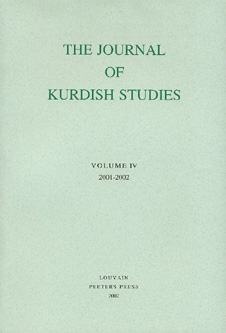next article in this issue  |

Preview first page |
Document Details : Title: Mahmûdî Clan and Order, 1500-1606 Author(s): REID, James J. Journal: Journal of Kurdish Studies Volume: 4 Date: 2001-2002 Pages: 1-17 DOI: 10.2143/JKS.4.0.519245 Abstract : Sharaf Khân Bidlîsî's history of the Kurdish clans belonged to Safavid-era Persian Literarture, composed in the style of the sabk-i Hindî. This form of literary expression can be compared with Baroque literature of western Europe. The rhetorical fashion of the sabk-i Hindî thus took a simple or relatively simple idea, and inflated the expression of tha tidea into a more semantic form. Rather than writing in a simple, colloquial style, Sharaf Khân, like almost all other contemporary writers, felt compelled to find most obscure and even difficult-to-understand Arabic terminology. The creation of complexity was focued on the liberal use of an Arabic-language facility in the composition of texts. Kurdish words appear only rarely n the Sharaf-Nâma, except, of course, those Persian and Arabic words common to both languages. The primary weakness of Sharaf-Nâma rested in its poor for dating events. On the other hand, Sharaf Khân's chronicle surpasses other period chrnicles in giving the genealogies of ruling families. On trait that Sharaf Khân had in common with both Safavid and Ottoman chroniclrs was his unwillingsness to give information about individuals and even entire groups of people at the levels below the highest elite in the group he was discussing. |
|


